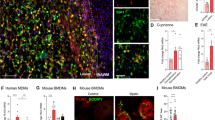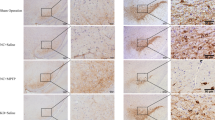Abstract
Excessive production of inflammatory mediators such as nitric oxide (NO) and proinflammatory cytokines from activated microglia in the central nervous system contributes to uncontrolled inflammation in neurodegenerative disorders. In this study, we investigated the anti-inflammatory activities of the methylene chloride fraction of JP05 (JP05-MC) on the production of inflammatory mediators in lipopolysaccharide (LPS)-stimulated BV2 mouse microglial cells, and its mechanism of action. JP05-MC significantly inhibited LPS-induced production of NO and the proinflammatory cytokines, TNF-α and IL-6, in BV2 cells. JP05-MC also attenuated the mRNA expression and protein levels of inducible nitric oxide synthase in LPS-induced BV2 cells. JP05-MC significantly attenuated LPS-elicited phosphorylation of the mitogen-activated protein kinase (MAPK), extracellular-signal-regulated kinase 1/2, and nuclear factor-κB (NF-κB) nuclear translocation in BV2 cells. Our results indicate that JP05-MC exerts anti-inflammatory properties via downregulation of inflammatory mediator gene transcription by suppressing the MAPK and NF-κB pathways, suggesting that JP05-MC may have therapeutic potential as an anti-inflammatory agent in neurodegenerative diseases.






Similar content being viewed by others
References
McGeer, E.G., and P.L. McGeer. 2007. The role of anti-inflammatory agents in Parkinson's disease. CNS Drugs 21: 789–797.
Kim, Y.S., and T.H. Joh. 2005. Microglia, major player in the brain inflammation: their roles in the pathogenesis of Parkinson's disease. Experimental & Molecular Medicine 38: 333–347.
Jung, H.W., C.H. Yoon, K.M. Park, H.S. Han, and Y.-K. Park. 2009. Hexane fraction of Zingiberis rhizome crudus extract inhibits the production of nitric oxide and proinflammatory cytokines in LPS-stimulated BV2 microglial cells via the NF-kappaB pathway. Food and Chemical Toxicology 47: 1190–1197.
Ha, J.A., and L.J. Lim. 1998. Antitumor and immune modulatory effects of Bojungtang in ICR mice. Korean Journal of Oriental Pathology 12: 90–98.
Irie, Y., and W.M. Keung. 2003. Rhizoma acori graminei and its active principles protect PC-12 cells from the toxic effect of amyloid-beta peptide. Brain Research 963: 282–289.
Chang, G.T., S.Y. Min, J.H. Kim, S.H. Kim, J.K. Kim, and C.H. Kim. 2005. Anti-thrombic activity of Korean herbal medicine, Dae-Jo-Whan and its herbs. Vascular Pharmacology 43: 283–288.
Kang, M., J.H. Kim, C. Cho, H.S. Chung, Y.S. Yoon, Y. Lee, M. Hong, M. Shin, and H. Bae. 2006. Effect of Acori graminei Rhizoma on contractile dysfunction of ischemic and reperfused rat heart. Biological & Pharmaceutical Bulletin 29: 483–488.
Kim, C.H., B.S. Koo, K.O. Kim, Y.C. Chang, and I.S. Lee. 2006. Salviae miltiorrhizae radix increases dopamine release of rat and pheochromocytoma PC12 cells. Phytotherapy Research 20: 191–199.
Jeong, M.Y., J.S. Lee, J.D. Lee, N.J. Kim, J.W. Kim, and S. Lim. 2008. A combined extract of Cinnamomi Ramulus, Anemarrhenae Rhizoma and Alpiniae Officinari Rhizoma suppresses production of nitric oxide by inhibiting NF-kappaB activation in RAW 264.7 cells. Phytotherapy Research 22: 772–777.
Son, H.Y., H.W. Jung, W.K. Kim, and Y.K. Park. 2010. The vasoprotective effect of JP05 through the activation of PI3K/Akt-dependent eNOS and MEK/ERK pathways in brain endothelial cells. Journal of Ethnopharmacology 130: 607–613.
Mahesh, R., H.W. Jung, C.H. Han, C.W. Cho, and Y.K. Park. 2010. Joongpoongtang 05 (JP05) confers neuroprotection via anti-apoptotic activities in neuro-2a cells during oxygen-glucose deprivation and reperfusion. Toxicology in Vitro. doi:10.1016/j.tiv.2010.10.016.
Rock, R.B., and P.K. Peterson. 2006. Microglia as a pharmacological target in infectious and inflammatory diseases of the brain. Journal of Neuroimmune Pharmacology 1: 117–126.
Boje, K.M., and P.K. Arora. 1992. Microglia-produced nitric oxide and reactive nitrogen oxides mediate neuronal cell death. Brain Research 853: 236–244.
Murakami, A. 2009. Chemoprevention with phytochemicals targeting inducible nitric oxide synthase. Forum of Nutrition 61: 193–203.
Dinarello, C.A. 1999. Cytokines as endogenous pyrogens. The Journal of Infectious Diseases 179: 294–304.
Yang, L.P., X.A. Zhu, and M.O. Tso. 2007. Minocycline and sulforaphane inhibited lipopolysaccharide-mediated retinal microglial activation. Molecular Vision 13: 1083–1093.
Labuzek, K., S. Liber, B. Gabryel, L. Buldak, and B. Okopien. 2010. Ambivalent effects of compound C (dorsomorphin) on inflammatory response in LPS-stimulated rat primary microglial cultures. Naunyn-Schmiedeberg’s Archives of Pharmacology 381: 41–57.
Ji, C., H.A. Aisa, N. Yang, Q. Li, T. Wang, L. Zhang, K. Qu, H.B. Zhu, and P.P. Zuo. 2008. Gossypium herbaceam extracts inhibited NF-kappaB activation to attenuate spatial memory impairment and hippocampal neurodegeneration induced by amyloid beta in rats. Journal of Alzheimer's Disease 14: 271–283.
Terai, K., A. Matsuo, E.G. McGeer, and P.L. McGeer. 1996. Enhancement of immunoreactivity for NF-kappaB in human cerebral infarctions. Brain Research 739: 343–349.
Xie, Q.W., Y. Kashiwabara, and C. Nathan. 1994. Role of transcription factor NF-kappaB/Rel in induction of nitric oxide synthase. The Journal of Biological Chemistry 269: 4705–4708.
Tang, N.Y., C.H. Liu, C.T. Hsieh, and C.L. Hsieh. 2010. The anti-inflammatory effect of paeoniflorin on cerebral infarction induced by ischemia-reperfusion injury in Sprague–Dawley rats. The American Journal of Chinese Medicine 38: 51–64.
Choi, S.Y., E.M. Ahn, M.C. Song, D.W. Kim, J.H. Kang, O.S. Kwon, T.C. Kang, and N.I. Baek. 2005. In vitro GABA-transaminase inhibitory compounds from the root of Angelica dahurica. Phytotherapy Research 19: 839–845.
Nakajima, Y., M. Shimazawa, S. Mishima, and H. Hara. 2007. Water extract of propolis and its main constituents, caffeoylquinic acid derivatives, exert neuroprotective effects via antioxidant actions. Life Sciences 80: 370–377.
Kang, S.Y., and Y.C. Kim. 2007. Decursinol and decursin protect primary cultured rat cortical cells from glutamate-induced neurotoxicity. The Journal of Pharmacy and Pharmacology 59: 863–870.
Acknowledgments
This study was supported by a grant from the Oriental Medicine R&D Project, Ministry of Health, Welfare and Family Affairs (B080027) and by the National Research Foundation Grant funded by the Korean Government (KRF-2009-353-E00035), Republic of Korea.
Conflict of Interest
The authors have declared that there is no conflict of interest.
Author information
Authors and Affiliations
Corresponding author
Rights and permissions
About this article
Cite this article
Jung, H.W., Oh, T.W., Jung, J.K. et al. Inhibitory Effects of the Methylene Chloride Fraction of JP05 on the Production of Inflammatory Mediators in LPS-activated BV2 Microglia. Inflammation 35, 332–341 (2012). https://doi.org/10.1007/s10753-011-9323-7
Published:
Issue Date:
DOI: https://doi.org/10.1007/s10753-011-9323-7




